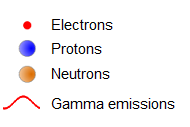2.3.4 Gamma emission (decay)
Gamma rays can be produced by a wide range of phenomena, including the radioactive decay processes.
The daughter nucleus that originates from disintegration is sometimes in an excited state (such as ionized atom). It can then decay to a lower energy state by emitting a gamma ray photon, in a process called gamma decay. Gamma decay may also follow nuclear reactions such as neutron capture, nuclear fission, or nuclear fusion.
Gamma radiation is electromagnetic radiation. Gamma rays travel at the speed of light (c), and have an energy (E) related to its wave length (λ):
E = hc/λ
where:
h = Planck’s constant 6.6261×10-34 Js;
